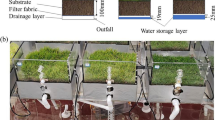Abstract
This study focuses on the water loss of green roof systems due to evapotranspiration, which is the combination of evaporation and transpiration processes. Water loss through evapotranspiration increases the capacity of a green roof to intercept additional stormwater during the following rain event and keep it out of the municipal stormwater system. Hence it is important that amount of water loss through a green roof, with known plant and growth medium properties and climate conditions, can be quantified. A theoretical model based on energy equation is used and MATLAB is employed in solving the equations due to the complexity of the problem. Relevant heat transfer equations with appropriate thermophysical properties of materials are used. Values obtained from the theoretical analysis are compared with experimental values that were gathered via a field project in which different green roof samples were tested for 2.5 years in terms of their weight under wet and dry seasonal conditions. The results from the theoretical model are found to be in close agreement with the experimental measurements, which is encouraging for predicting water loss of green roof systems in different geographic locations with known climate conditions.
Access this chapter
Tax calculation will be finalised at checkout
Purchases are for personal use only
Similar content being viewed by others

Abbreviations
- A:
-
Area, m2
- C:
-
Bulk transfer coefficient
- cp :
-
Specific heat, J/kgK
- H:
-
Sensible heat flux, W/m2
- h:
-
Enthalpy, J/kg
- I:
-
Solar radiation, W/m2
- K:
-
Thermal conductivity, W/mK
- L:
-
Latent heat flux, W/m2
- LAI:
-
Leaf area index
- m:
-
Mass, kg
- P:
-
Volume, m3
- Q:
-
Mixing ratio
- r″:
-
Surface wetness factor
- S:
-
Solar peak hours, h/day
- T:
-
Temperature, K
- W:
-
Wind speed, m/s
- Z:
-
Height, m
- α:
-
Surface albedo
- Δ:
-
Net change
- ɛ:
-
Emissivity
- ρ:
-
Density, kg/m3
- σ:
-
Amount of foliage covered
- A:
-
Air
- dir:
-
Direct
- evap:
-
Evaporation
- f:
-
Foliage
- g:
-
Growth medium
- sat:
-
Saturation
References
Schroll E, Lambrinos J, Righetti T, Sandrock D (2011) The role of vegetation in regulating stormwater runoff from green roofs in a winter rainfall climate. Ecol Eng 37:595–600
Bengtsson L (2005) Peak flows from thin sedum-moss roof. Nord Hydrol 36:269–80
Monterusso MA, Rowe DB, Rugh CL, Russell DK (2004) Runoff water quantity and quality from green roof systems. Acta Hort 639:369–73
Villareal EL, Semadeni-Davies A, Bengtsson L (2004) Inner city stormwater control using a combination of best management practices. Ecol Eng 22:279–98
Bliss DJ, Neufeld RD, Ries RJ (2009) Storm water runoff mitigation using a green roof. Environl Eng Sci 26(2):407–17
Berndtsson JC (2010) Green roof performance towards management of runoff water quantity and quality: a review. Ecol Eng 36:351–60
Stanford RL, Yu SL, Ruifen L, Field R, Tafuri AN, Luo L, Deng Y (2011) Performance evaluation of different green roof designs - Chengdu, China. Low impact development symposium. Philadelphia, PA, 25–28 Sept 2011.
Gregoire BG, Clausen JC (2011) Effect of a modular extensive green roof on storm water runoff and water quality. Ecol Eng 37:963–9
Richter L (2010) Stormwater loss through evapotranspiration from green roof systems. Master’s Thesis. Southern Illinois University Edwardsville.
Karanam NH (2012) Analysis of water loss by evapotranspiration from green roof systems. Master’s Thesis. Southern Illinois University Edwardsville.
Frankenstein S, Koenig GG (2004) Fast all-season soil strength. Technical report TR-04-25. US Army Engineer Research and Development Center, Hanover, NH.
Sailor DJ (2008) A green roof model for building energy simulation programs. Energ Buildings 40:1466–78
Feller MM (2011) Quantifying evapotranspiration in green infrastructure: a green roof case study. Master’s Thesis. Villanova University.
Wohling T, Schmitz GH (2007) Physically based coupled model for simulating 1D surface – 2D subsurface flow and water uptake in irrigation furrows: model development. J Irrig Drain E-ASCE 133:538–47
Author information
Authors and Affiliations
Corresponding author
Editor information
Editors and Affiliations
Rights and permissions
Copyright information
© 2013 Springer Science+Business Media New York
About this chapter
Cite this chapter
Karanam, H., Retzlaff, W., Morgan, S., Celik, S. (2013). Experimental and Theoretical Analysis of Evapotranspiration in Green Roof Systems. In: Dincer, I., Colpan, C., Kadioglu, F. (eds) Causes, Impacts and Solutions to Global Warming. Springer, New York, NY. https://doi.org/10.1007/978-1-4614-7588-0_57
Download citation
DOI: https://doi.org/10.1007/978-1-4614-7588-0_57
Published:
Publisher Name: Springer, New York, NY
Print ISBN: 978-1-4614-7587-3
Online ISBN: 978-1-4614-7588-0
eBook Packages: EnergyEnergy (R0)



